Abstract
Free full text

Surfactant proteins A and D protect mice against pulmonary hypersensitivity induced by Aspergillus fumigatus antigens and allergens
Abstract
Allergic bronchopulmonary aspergillosis (ABPA) is an allergic disorder caused by an opportunistic fungal pathogen, Aspergillus fumigatus (Afu). Lung surfactant proteins SP-A and SP-D can interact with the glycosylated antigens and allergens of Afu, inhibit specific IgE binding to these allergens, and block histamine release from sensitized basophils. We have now examined the therapeutic effect of exogenous administration of human SP-A, SP-D, and a recombinant fragment of SP-D (rSP-D), in a murine model of pulmonary hypersensitivity induced by Afu antigens and allergens, which resembles human ABPA immunologically. The ABPA mice exhibited high levels of Afu-specific IgG and IgE, blood eosinophilia, extensive infiltration of lymphocytes and eosinophils in the lung sections, and a Th2 cytokine response. Treatment with SP-A, SP-D, and rSP-D lowered blood eosinophilia, pulmonary infiltration, and specific Ab levels considerably, which persisted up to 4 days in the SP-A–treated ABPA mice, and up to 16 days in the SP-D– or rSP-D–treated ABPA mice. The levels of IL-2, IL-4, and IL-5 were decreased, while the level of IFN-γ was raised in the splenic supernatants of the treated mice, indicating a marked shift from Th2 to Th1 response. These results clearly implicate pulmonary SP-A and SP-D in the modulation of allergic reactions.
Introduction
Allergic bronchopulmonary aspergillosis (ABPA), an allergic disorder induced by the fungal pathogen Aspergillus fumigatus (Afu), is characterized by the presence of both type I and type III hypersensitivity reactions leading to increased levels of total IgE, specific IgE (Afu-IgE), specific IgG (Afu-IgG), and blood and pulmonary eosinophilia (1). In ABPA, as in classic asthma, the activation of specific T-helper cells leads to the development of a cytokine cascade with increased production of IgE and recruitment of eosinophils and basophils. ABPA is clearly distinguished from other hypersensitivity responses to inhaled allergens in that the Afu conidia grow in the respiratory tract and continually shed soluble and particulate antigens and allergens in the large subsegmental bronchi. The frequent occurrence of ABPA in recent years, notably in patients with cystic fibrosis, AIDS, and asthma, has stimulated renewed interest in its pathogenesis and the development of novel therapeutics (2).
Lung surfactant proteins, SP-A and SP-D, also called “collectins,” are known to interact with carbohydrate structures on the surfaces of a wide range of pathogens, such as viruses, bacteria, and fungi via their carbohydrate recognition domains (CRDs) and enhance phagocytosis and killing by neutrophils and macrophages (3, 4). Collectins are composed of subunits, each of which contains a collagen-like triple-helical region, followed by an α-helical, trimerizing neck region and three CRDs at its COOH-terminal end. Six of these trimeric subunits make up the overall structure of SP-A, while SP-D is composed of a cruciform-like structure with four arms of equal length (5). The roles of SP-A and SP-D in the pathogenesis of airway inflammation and asthma have been addressed recently. Abnormal levels of SP-A and SP-D in the lung lavage have been reported in the adult respiratory distress syndrome (ARDS) and pulmonary infections caused by influenza virus, mycoplasma, and Pneumocystis carinii in AIDS, pulmonary hypersensitivity, and cystic fibrosis (6, 7). SP-A is known to bind to water-extractable, allergic glycoproteins from pollen grains (8). SP-A and SP-D can also bind glycoprotein allergens present in the house dust mite (Dermatophagoides pteronyssinus) and extract and inhibit the binding of allergen-specific IgE to mite allergens (9), suggesting that these surfactant proteins may be involved in modulating allergic reactions.
Previously, we have demonstrated that human SP-A, SP-D, and a recombinant fragment of SP-D (rSP-D), composed of trimeric neck and CRD regions, could bind to the Afu 3-week culture filtrate (3wcf) and two immunodominant glycoprotein allergens, gp55 and gp45, in a carbohydrate-specific and calcium-dependent manner, inhibit the ability of Afu-IgE to bind these allergens, and block Afu allergen-induced histamine release from sensitized basophils isolated from ABPA patients (10). SP-A and SP-D have been reported to reduce the proliferation of PBMCs isolated from mite-sensitive asthmatic children (11), and SP-D, in particular, has a suppressive effect on the secretions of IL-2 by PBMCs (12). To further dissect the protective roles of SP-A and SP-D in the pathogenesis of ABPA, we have now examined the therapeutic effect of exogenous administration of purified preparations of human SP-A, SP-D, and rSP-D in a murine model of fungal hypersensitivity caused by allergens and antigens of Afu (which mimic immunological parameters of human ABPA). Our results strongly implicate the involvement of SP-A and SP-D in protection against allergen-mediated immune reactions.
Methods
Mice.
Specific-pathogen-free, 6- to 8-week-old BALB/c mice were obtained from the National Centre for Laboratory Animal Sciences (National Institute of Nutrition, Indian Council of Medical Research, Jamai-Osmania, Hyderabad, India) and Harlan-OLAC, Shaw’s Farm (Bicester, Oxfordshire, United Kingdom). They received Purina chow and acidified water ad libitum. Mice were randomized before experiments were performed.
Antigens.
The 3wcf (protein-enriched antigenic fraction, 27 mg/ml) of Afu (strain 285, isolated from sputum of an ABPA patient visiting the V. Patel Chest Institute, Delhi, India) was used to sensitize the mice. Culture filtrate antigens were prepared by growing the organism in a synthetic broth (L-asparagine medium) for 3 weeks at 37°C in a stationary culture. The mycelia were removed by filtration, and the filtrate was dialyzed extensively against distilled water, followed by ammonium sulfate precipitation and lyophilization. The antigen preparation was characterized by 15% (wt/vol) SDS-PAGE, and its reactivity with pooled patients’ sera was examined using ELISA and Western blot analysis.
Human sera.
The ABPA patients’ sera used in the study were obtained from clinically confirmed cases (satisfying Rosenberg’s criteria) registered at V. Patel Chest Institute. Serum, obtained from healthy, consenting donors with no history of pulmonary disease, was used as control.
Preparation of native human SP-A and SP-D.
Native human SP-A and SP-D were purified from the lung lavage obtained from alveolar proteinosis patients, as described previously (13), and were judged to be pure by using SDS-PAGE (Figure (Figure1b),1b), Western blot analysis, and amino acid composition. They were found to be free from IgG, IgM, and IgE contamination with ELISA using anti-human IgG, anti-human IgM, and anti-human IgE peroxidase conjugates, respectively. SP-A and SP-D preparations were also examined for endotoxin levels using the QCL-1000 Limulus amebocyte lysate system (BioWhittaker Inc., Walkersville, Maryland, USA). The assay was linear over a range of 0.1–1.0 EU/ml (10 EU = 1 ng of endotoxin). The amount of endotoxin was found to be 16 pg/μg of SP-A and 56 pg/μg of SP-D.
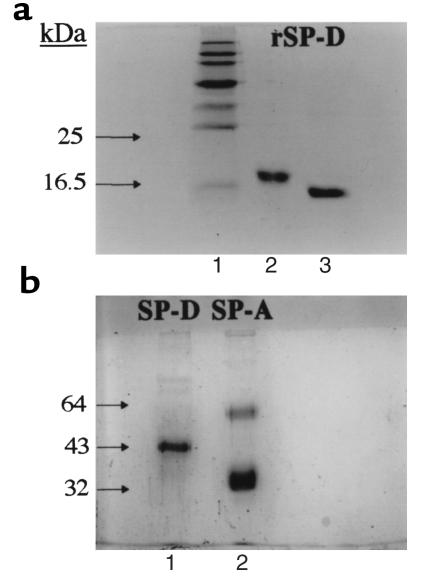
(a) SDS-PAGE (15% wt/vol) analysis of purified preparations of rSP-D under reducing as well as nonreducing conditions (Coomassie staining). A recombinant, homotrimeric fragment composed of the eight Gly-Xaa-Yaa repeats, α-helical coiled-coil neck region, and CRD of human SP-D was expressed in E. coli as the inclusion bodies and purified. The recombinant protein behaved as a homotrimer of about 60 kDa when examined by gel filtration chromatography and chemical cross-linking (data not shown). Under reducing conditions (lane 2), it ran as a monomer of about 18 kDa. No higher oligomers were seen when rSP-D was run under nonreducing conditions (lane 3), confirming that the trimerization was not a result of aberrant disulfide bridges between CRD regions. The rSP-D was also assessed for correct folding using disulfide mapping, and its crystallographic structure complexed with maltose in the carbohydrate-binding pockets (A.K. Shrive et al., unpublished data). (b) SDS-PAGE (10% wt/vol) analysis of purified preparations of SP-D and SP-A under reducing conditions (Coomassie staining). The majority of SP-D is composed of a 43-kDa polypeptide chain (lane 1) with faint bands corresponding to dimers and trimers of the 43-kDa chain (confirmed by immunoblotting). Two bands are seen, a major band corresponding to the 32-kDa polypeptide chain of SP-A (lane 2), together with a proportion of nonreducible dimers (64 kDa). Traces of higher oligomers and some aggregates (confirmed by immunoblotting) can also been seen. The nonreduced preparations of SP-D and SP-A behaved on SDS-PAGE as described previously (13).
Expression and purification of rSP-D.
A recombinant homotrimer, composed of eight Gly-Xaa-Yaa repeats from the collagen region, α-helical coiled-coil neck region, and CRD of human SP-D, was expressed in Escherichia coli and purified by a procedure involving denaturation and renaturation of the inclusion bodies, ion-exchange, affinity and gel-filtration chromatography. The recombinant preparation was judged to be pure by using SDS-PAGE (Figure (Figure1a),1a), immunoblotting, and amino-terminal sequencing. The purified recombinant protein was assessed for correct folding using disulfide mapping and its crystallographic structure complexed with maltose in the carbohydrate-binding pockets (A.K. Shrive et al., unpublished data). The rSP-D was also examined for its binding to simple sugars, phospholipids, and maltosyl-BSA, as described previously (14). The amount of endotoxin present in the rSP-D preparations was estimated as described above for native SP-A and SP-D preparations and found to be 42 pg/μg of rSP-D.
Immunization of mice.
Mice were divided into ten groups, with eight mice in each group (untreated ABPA mice, untreated control mice, SP-A–treated ABPA mice, SP-A–treated control mice, SP-D–treated ABPA mice, SP-D–treated control mice, rSP-D–treated ABPA mice, rSP-D–treated control mice, BSA-treated ABPA mice, and BSA-treated control mice). A murine model of pulmonary hypersensitivity was prepared as described previously (15) and called “ABPA mice” for descriptive convenience. Briefly, animals in the ABPA mice groups were lightly anesthetized with ether, and 50 μl (100 μg) of the antigen mixture per mouse was slowly applied to the nostrils using a micropipette with a sterile disposable tip. After inoculation, the animals were held upright for a few minutes, until all antigen applied to the nostril was completely inhaled. These mice also received 100 μl (200 μg) of the same antigen mixture per mouse intraperitoneally. Intranasal instillation and intraperitoneal injections were given twice a week to each mouse for 4 weeks (28 days). The last immunization with antigen was carried out on 28th day (named day 0 for the treatment study), followed by treatment with surfactant proteins or BSA (Sigma Chemical Co., St. Louis, Missouri, USA), for the next 3 days (day 1, 2, and 3 of the treatment study). Mice in the control groups were immunized identically, but with sterile PBS.
Administration of SP-A, SP-D, and rSP-D.
Groups of untreated ABPA mice and untreated control mice were intranasally administered 50 μl of PBS on days 1, 2, and 3. Groups of mice receiving treatment were named after respective proteins being administered. Human SP-A (3 μg in 50 μl of PBS per mouse) was intranasally administered to SP-A–treated ABPA mice and SP-A–treated control mice on days 1, 2, and 3. Human SP-D (1 μg in 50 μl of PBS per mouse) was intranasally administered to the SP-D–treated ABPA mice and SP-D–treated control mice on days 1, 2, and 3. The rSP-D (1 μg in 50 μl of PBS per mouse) was intranasally administered to the groups of rSP-D–treated ABPA mice and rSP-D–treated control mice on days 1, 2, and 3. BSA (3 μg in 50 μl of PBS per mouse) was intranasally administered to BSA-treated ABPA mice and BSA-treated control mice groups on days 1, 2, and 3. The selected dose of SP-A and SP-D was based on the physiological concentrations of these proteins reported in rodent lung lavage: the SP-A concentration in the rat lavage was 7.3 ± 0.8 μg/ml and the SP-D concentration in the lavage from C57Bl/6 mice 6–8 weeks of age was observed to be 552 ng/ml (16, 17). For human lung lavage, the SP-A concentration ranges from 1 to 10 μg/ml and the SP-D concentration varies between 300 ng and 600 ng/ml (7, 18).
Afu-IgG and Afu-IgE Ab’s in mice.
The Afu-IgG and Afu-IgE levels in the serum were measured by ELISA, as described previously (19). The serum dilutions used for IgG and IgE estimation were 1:50 (vol/vol) and 1:25 (vol/vol), respectively. Protein A peroxidase (for IgG) conjugate and anti-mouse IgE peroxidase conjugate (for IgE) were used at 1:1000 (vol/vol) dilutions.
Peripheral blood eosinophilia.
The eosinophils were counted on a hemocytometer, using 1 μl heparinized blood stained with 9 μl of Dunger’s reagent (an aqueous solution containing 0.1% wt/vol eosin, 10% vol/vol acetone, and 0.1% wt/vol Na2CO3).
Preparation of single-cell suspension from lungs.
Lungs were isolated from mice and homogenized in RPMI-1640 medium containing 10% (vol/vol) bovine serum at a concentration of 5 × 105 cells/ml.
Eosinophil peroxidase assay.
For the eosinophil peroxidase assay (EPO), lung cell suspension (200 μl/well) was plated in a 96-well tissue culture plate and incubated in a humidified CO2 incubator at 37°C for 48 hours. The medium was aspirated and o-phenylene diamine (OPD) was added (100 μl of 1 mM solution was prepared using sterile PBS containing 0.1% vol/vol Triton X-100 and 0.0125% vol/vol H2O2). After 30-minute incubation at room temperature, the color reaction was terminated by addition of 50 μl of 4 N H2SO4, and the A490 was measured.
Cytokines in spleen cultures.
Spleens from mice sacrificed at different time intervals were collected aseptically. Organs were minced, and cells were suspended in culture medium (2 × 106 cells/well) and allowed to proliferate in RPMI-1640 medium with 10% (vol/vol) bovine serum and 10 μg/ml gentamicin. The supernatant was collected after 72-hour incubation and assayed for the levels of IL-2, IL-4, IL-5, and IFN-γ, according to the manufacturer’s instructions (Endogen Inc., Cambridge, Massachusetts, USA).
Histological examination of the lung sections.
Lungs removed from the sacrificed mice were trimmed of extraneous tissue and fixed in 10% (vol/vol) formaldehyde and stored at 4°C. The tissue sections, made using a microtome and stained with hematoxylin and eosin, were examined at ×200 as well as ×500.
Statistical analysis.
All data were expressed as mean plus or minus SD and compared using the one-population ANOVA test using the MicroCal Origin Version 3.0 statistical package (MicroCal Software Inc., Northampton, Massachusetts, USA). Cytokine data were compared using unpaired two-tailed Mann-Whitney (nonparametric) test. The P values were considered statistically significant if they were less than 0.05.
Results
Afu-IgG and Afu-IgE Ab’s in mouse sera.
A significant increase in Afu-IgG and Afu-IgE levels was observed in the groups of mice immunized for 4 weeks with 3wcf (the ABPA mice groups before any treatment), in comparison with those of control mice (the control groups before any treatment) immunized with PBS alone (Figures (Figures22 and and3;3; significantly different at P < 0.05). On intranasal administration of SP-A (3 μg/mouse), SP-D (1 μg/mouse), and rSP-D (1 μg/mouse) for 3 consecutive days to the groups of SP-A–treated ABPA mice, SP-D–treated ABPA mice, and rSP-D–treated ABPA mice, respectively, the Afu-IgG levels decreased in comparison with the untreated ABPA mice and BSA-treated ABPA mice groups and continued to do so until the day 16 of the treatment study (Figure (Figure2).2). The SP-A–treated ABPA mice showed the lowest Afu-IgG levels on day 16 of the treatment study with a ratio of 1.512 ± 0.075 to 1 for the SP-A–treated control mice (decreased from the 0-day level of 2.752 ± 0.132 to 1). The SP-D–treated and rSP-D–treated ABPA mice groups also showed significant decreases in the Afu-IgG levels in the serum in comparison with their respective controls. The Afu-IgG levels in the groups of control mice were not affected by administration of SP-A, SP-D, rSP-D, and BSA, and were comparable to those of the untreated control groups. The ratios of Afu-IgE levels on day 16 of the treatment study in various groups — untreated ABPA mice, SP-A–treated ABPA mice, SP-D–treated ABPA mice, rSP-D–treated ABPA mice, and BSA-treated ABPA mice — to their respective control groups were 3.137 ± 0.098, 1.964 ± 0.089, 1.792 ± 0.082, 1.745 ± 0.076, and 3.227 ± 0.126, respectively (Figure (Figure3).3). The BSA-treated ABPA mice and control mice showed an increase in Afu-IgE levels (Afu-IgE absorbance for BSA-treated ABPA mice on day 0 and day 16 was 0.302 ± 0.017 and 0.338 ± 0.017 and for BSA-treated control mice on day 0 and day 16 was 0.082 ± 0.007 and 0.105 ± 0.005, respectively). Intranasal administration of human SP-A, SP-D, and rSP-D resulted in significant decrease in the Afu-IgE levels in the serum in comparison with the untreated ABPA mice. Administration of SP-A, SP-D, and rSP-D did not affect the Afu-IgE levels significantly in control groups of mice.
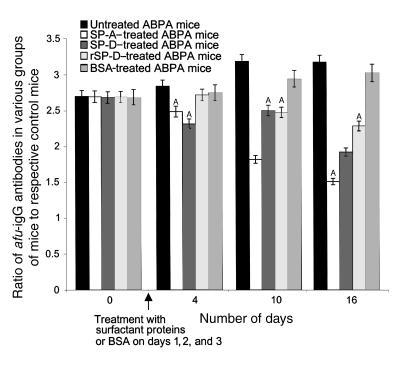
Ratio of Afu-IgG Ab’s (estimated by indirect ELISA as described in Methods) of the untreated ABPA mice (black bars), SP-A–treated ABPA mice (white bars), SP-D–treated ABPA mice (dark gray bars), rSP-D–treated ABPA mice (light gray bars), and BSA-treated ABPA mice (medium gray bars) to their respective controls observed on day 0, 4, 10, and 16 of the treatment study. Each value represents a mean of nine readings (triplicate values from three animals of each group). Absorbance values ± SD for each control group observed on day 16 are as follows: untreated control, 0.158 ± 0.020; SP-A–treated control, 0.13 ± 0.013; SP-D–treated control, 0.118 ± 0.011; rSP-D–treated control, 0.120 ± 0.009; and BSA-treated control, 0.158 ± 0.015. AP < 0.05 compared with the values of the untreated ABPA mice on the same day.
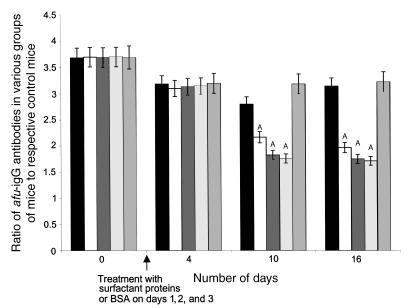
Ratio of Afu-IgE Ab’s (estimated by indirect ELISA as described in Methods) of the untreated ABPA mice (black bars), SP-A–treated ABPA mice (white bars), SP-D–treated ABPA mice (dark gray bars), rSP-D–treated ABPA mice (light gray bars), and BSA-treated ABPA mice (medium gray bars) to their respective controls observed on day 0, 4, 10, and 16 of the treatment study. Each value represents a mean of nine readings (triplicate values from three animals of each group). Absorbance values ± SD for the control groups observed on day 16 are as follows: untreated control, 0.095 ± 0.011; SP-A–treated control, 0.072 ± 0.014; SP-D–treated control, 0.068 ± 0.012; rSP-D–treated control, 0.071 ± 0.010; and BSA-treated control (0.105 ± 0.018). AP < 0.05 compared with the values of the untreated ABPA mice on the same day.
Peripheral blood eosinophilia.
Figure Figure44 shows the ratio of peripheral blood eosinophil counts of the four groups of sensitized mice versus control groups of nonsensitized mice during the study. On the day 4 of the treatment, a significant rise in the number of eosinophils in peripheral blood was observed in the untreated ABPA mice as well as BSA-treated ABPA mice in response to the antigenic challenge on day 0, while the ABPA mice, treated with SP-A, SP-D, and rSP-D, showed a decline in the peripheral blood eosinophilia. Although the SP-A–treated ABPA mice initially had reduced peripheral blood eosinophilia (up to day 4 of the treatment study), there was a gradual increase in the eosinophil counts compared with the groups of untreated ABPA mice and BSA-treated ABPA mice. During 16 days of the treatment study, the eosinophil counts decreased in all the groups of ABPA mice. However, there was significant lowering of eosinophil counts in the SP-D– and rSP-D–treated mice, as compared with the untreated, BSA-treated, or SP-A–treated ABPA mice groups, on day 10 and 16. The eosinophil counts were not significantly different in the various groups of control mice.

Ratio of eosinophil counts in the peripheral blood of the untreated ABPA mice (black bars), SP-A–treated ABPA mice (white bars), SP-D–treated ABPA mice (dark gray bars), rSP-D–treated ABPA mice (light gray bars), and BSA-treated ABPA mice (medium gray bars) to their respective controls observed on day 0, 4, 10, and 16 of treatment study. Each value represents a mean of nine readings (triplicate values from three animals of each group). Numbers of eosinophils × 106/ml ± SD for the control groups observed on day 16 are as follows: untreated control, 58 ± 7 × 106/ml; SP-A–treated control, 45 ± 6 × 106/ml; SP-D–treated control, 42 ± 8 × 106/ml; rSP-D–treated control, 44 ± 4 × 106/ml; and BSA-treated control, 61 ± 5 × 106/ml. AP < 0.05 compared with the values of the untreated ABPA mice on the same day.
Lung histology.
As shown in Figure Figure5,5, histopathological examination of lung sections revealed that the ABPA mice treated with PBS alone (Figure (Figure5a)5a) and BSA (Figure (Figure5c)5c) showed extensive chronic inflammatory infiltrates, mainly representing lymphocytes and eosinophils (with characteristic bilobed nuclei, insets in Figure Figure5).5). These inflammatory cells were frequently located around perivascular and peribronchiolar areas. Mice in the nonsensitized control groups, such as untreated (Figure (Figure5b),5b), BSA-treated (Figure (Figure5d),5d), SP-A–treated (Figure (Figure5f),5f), SP-D–treated (Figure (Figure5h),5h), and rSP-D–treated controls (Figure (Figure5j),5j), had normal bronchi and parenchyma and had no conspicuous cellular infiltrates. When examined on the day 16 of the treatment study, the infiltration was markedly reduced in the SP-A–treated ABPA mice (Figure (Figure5e),5e), SP-D–treated ABPA mice (Figure (Figure5g),5g), and rSP-D–treated ABPA mice (Figure (Figure55i).
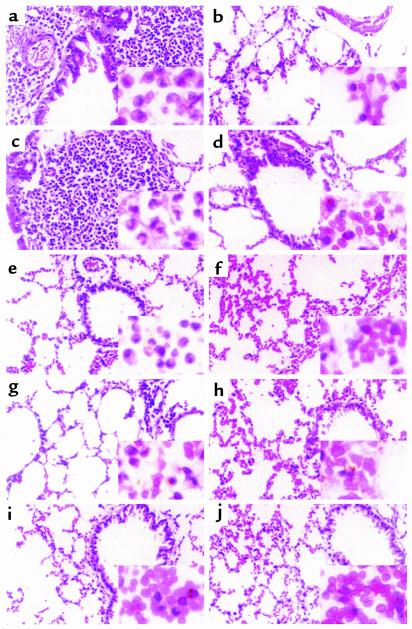
Histopathological examination of the lung sections, stained with hematoxylin and eosin (H&E) and observed at ×200, from the groups of untreated and treated ABPA mice and their respective control groups on day 16 of the treatment study. (a) Untreated ABPA mice; (b) untreated control; (c) BSA-treated ABPA mice; (d) BSA-treated control; (e) SP-A–treated ABPA mice; (f) SP-A–treated control; (g) SP-D–treated ABPA mice; (h) SP-D–treated control; (i) rSP-D–treated ABPA mice; (j) rSP-D–treated control. The nature of cellular infiltration, which includes lymphocytes and eosinophils (with characteristic bilobed nuclei), is clearly seen in the inset (×500) of each panel.
Eosinophil peroxidase activity.
The levels of eosinophil peroxidase (EPO) activity in the lung suspensions of all the ABPA mice were raised quite significantly in comparison with the control mice on day 0 of the treatment study (Figure (Figure6),6), although a significant increase in peripheral eosinophilia seen on day 4 in the untreated and BSA-treated ABPA mice was not observed with the EPO activity of these groups. The ratio of EPO activity in the groups of untreated ABPA mice versus the untreated control mice on day 0 was found to be 1.752 ± 0.128, which gradually declined to 1.220 ± 0.068 on day 16 of the treatment study. Administration of SP-D and rSP-D reduced the EPO activity in the ABPA mice on day 4 after therapy. The ratio of SP-D–treated ABPA mice to SP-D–treated control mice was 0.589 ± 0.032 and that of the rSP-D–treated ABPA mice to the rSP-D–treated control mice was 0.941 ± 0.047. Administration of SP-A, SP-D, rSP-D, and BSA did not affect the EPO activity in the control mice. Furthermore, the BSA-treated ABPA mice did not show a significant lowering in EPO activity when compared with the untreated ABPA mice. Although SP-A treatment resulted in a decrease in the EPO activity initially (ratio of the SP-A–treated ABPA mice to the SP-A–treated control mice on day 4 of the treatment study was 0.968 ± 0.048), the levels became comparable to those in the untreated and BSA-treated ABPA mice groups on day 16 of the treatment study (ratio of the SP-A–treated ABPA mice to the SP-A–treated control mice on day 16 of the treatment study was 1.230 ± 0.052).
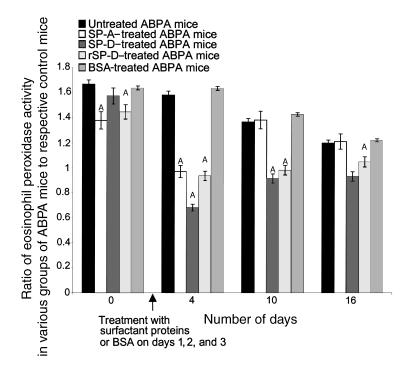
Ratio of lung EPO activity (estimated in the lung cell suspensions by a colorimetric substrate assay as described in Methods) of the untreated ABPA mice (black bars), SP-A–treated ABPA mice (white bars), SP-D–treated ABPA mice (dark gray bars), rSP-D–treated ABPA mice (light gray bars), and BSA-treated ABPA mice (medium gray bars) to their respective controls as observed on day 0, 4, 10, and 16 of the treatment study. Each value represents a mean of nine readings (triplicate values from three animals of each group). Absorbance values ± SD for the control groups observed on day 16 are as follows: untreated control, 0.252 ± 0.012; SP-A–treated control, 0.236 ± 0.015; SP-D–treated control, 0.242 ± 0.012; rSP-D–treated control, 0.225 ± 0.007; and BSA-treated control, 0.226 ± 0.001. AP < 0.05 compared with the values of the untreated ABPA mice on the same day.
Cytokines in splenic supernatants.
Administration of SP-A, SP-D, and rSP-D in the ABPA mice significantly changed the levels of IL-2, IL-4, IL-5, and IFN-γ on day 10 of the treatment study in comparison to their respective controls (Figure (Figure7).7). Ratios of IL-2, IL-4, IL-5, and IFN-γ levels in splenic supernatants of the untreated ABPA mice to their respective controls were found to be 2.744 ± 0.137, 5.469 ± 0.226, 1.750 ± 0.078, and 0.663 ± 0.039, respectively (Figure (Figure7).7). The levels of IL-2, IL-4, and IL-5 decreased while IFN-γ showed higher concentrations in the splenic supernatants of those ABPA mice that were treated with SP-A, SP-D, and rSP-D. The percentage increase in IFN-γ levels of SP-A–, SP-D–, and rSP-D–treated ABPA mice in comparison with the untreated ABPA mice was 136.25%, 93.82%, and 156.14%, respectively. The cytokine levels in the BSA-treated ABPA mice were not significantly different from the untreated ABPA mice. Administration of SP-A, SP-D, rSP-D, and BSA did not affect the cytokine levels in the control mice.
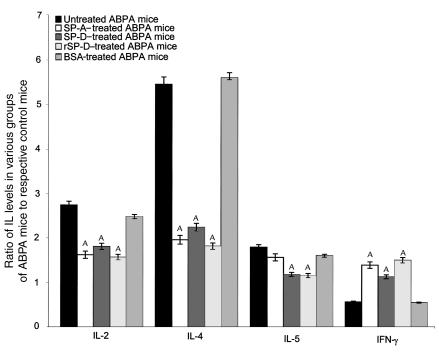
Ratios of IL-2, IL-4, IL-5, and IFN-γ in splenic supernatants from untreated ABPA mice (black bars), SP-A–treated ABPA mice (white bars), SP-D–treated ABPA mice (dark gray bars), rSP-D–treated ABPA mice (light gray bars), and BSA-treated ABPA mice (medium gray bars) groups to their respective control groups as observed on day 10 of the treatment study. Each value represents a mean of nine readings (triplicate values from three animals of each group). Cytokine levels ± SD for the control groups observed on day 10 are as follows: untreated control, IL-2: 19.286 ± 0.827 pg/ml; IL-4: 42.036 ± 2.101 pg/ml; IL-5: 22.436 ± 1.121 pg/ml; IFN-γ: 33.281 ± 1.691 ng/ml; SP-A–treated control, IL-2: 14.529 ± 0.726 pg/ml; IL-4: 39.048 ± 1.952 pg/ml; IL-5: 18.229 ± 0.911 pg/ml; IFN-γ: 29.476 ± 1.473 ng/ml; SP-D–treated control, IL-2: 15.016 ± 0.750 pg/ml; IL-4: 36.725 ± 1.837 pg/ml; IL-5: 17.548 ± 0.877 pg/ml; IFN-γ: 28.359 ± 1.417 ng/ml; rSP-D–treated control, IL-2: 14.856 ± 0.742 pg/ml; IL-4: 37.543 ± 1.877 pg/ml; IL-5: 19.212 ± 0.960 pg/ml; IFN-γ: 29.021 ± 1.451 ng/ml; and BSA-treated control, IL-2: 19.893 ± 0.815 pg/ml; IL-4: 49.135 ± 1.962 pg/ml; IL-5: 28.431 ± 0.989 pg/ml; IFN-γ: 28.941 ± 1.216 ng/ml. AP < 0.05 compared with the values of the untreated ABPA mice on the same day.
Discussion
ABPA, an allergic disorder induced by Afu, is clinically characterized by episodic bronchial obstruction, positive immediate skin reactivity (positive wheal and erythema reaction), presence of precipitins in serum to Afu antigens, elevated total IgE in serum, elevated Afu-IgG and Afu-IgE Ab’s in serum, peripheral and pulmonary eosinophilia, central bronchiectasis, and history of expectorating brown plugs or flecks (Rosenberg’s diagnostic parameters for ABPA). To assess the protective effects of SP-A and SP-D against Afu antigens and allergens, we have generated a murine model of fungal hypersensitivity using Afu antigens and allergens described previously. It appeared to mimic human ABPA with respect to the immunological parameters, such as peripheral blood and lung eosinophilia, elevated Afu-IgE and Afu-IgG levels, and Th2-type cytokine profile, as reported previously (15, 19). Although this murine model may not truly represent human ABPA, where the actively growing fungus sheds antigens and allergens continuously, it has helped our understanding of the role of eosinophilia, Afu-IgG, Afu-IgE, and Th response in its pathogenesis. For convenience, we have referred to this animal model as murine ABPA throughout the text.
In ABPA, Afu antigens and allergens cross-link mast cell–bound IgE with subsequent release of mediators such as histamine, leukotrienes, and platelet-activating factor (PAF), leading to bronchial smooth muscle contraction and vascular permeability. The leukotrienes B4 and PAF are known chemoattractants and stimulants for eosinophils. The Afu-IgG and Afu-IgE are also considered to bind Fc receptors present on eosinophils, leading to secretion of inflammatory mediators such as major basic protein and eosinophil-derived neurotoxins (2). In the present study, exposure to Afu antigens and allergens appeared to affect eosinophil differentiation, as inferred by the EPO activity (15). The observed correlation between eosinophilia and the Afu-IgE levels appeared to suggest a possible interaction between eosinophils and IgE in the pathogenesis of ABPA. We also observed an increase in the levels of IL-2, IL-4, and IL-5 and decrease in the level of IFN-γ in the splenic supernatants, in addition to elevated Afu-IgG levels, suggesting predominance of a Th2 response (characterized by secretion of IL-4, IL-5, IL-10, and IL-13 and generation of humoral immune responses) in the ABPA mice (20). IL-5 is a differentiation factor for eosinophils (21, 22). IL-4 is an important immunoglobulin switch factor for B cells, leading to the secretion of IgG1 (human IgG4) and IgE (23). The observation that IL-4 levels in splenic supernatants appeared to correlate with serum Afu-IgE levels, implicates IL-4 as a modulator of IgE production in the ABPA mice. IL-2 and its receptor are central to the growth and differentiation of T and B lymphocytes, natural killer (NK) cells, macrophages, and monocytes. An increase in the IL-2 levels in the ABPA mice probably causes clonal expansion of Afu-specific Th2 cells. Lower levels of IFN-γ in the splenic cultures of the ABPA mice, as also reported previously (20), is quite significant since IFN-γ, a Th1-type cytokine, promotes cellular immunity.
After intranasal administration of physiological concentrations of SP-A, SP-D, and rSP-D in the ABPA mice, we observed a sharp decline in the Afu-IgE and Afu-IgG levels and peripheral blood eosinophilia and pulmonary infiltration. Suppression of blood eosinophilia and specific Ab levels persisted up to 4 days in the SP-A–treated ABPA mice and up to 16 days in the SP-D– or rSP-D–treated ABPA mice. Cellular infiltration consisting of lymphocytes and eosinophils, seen in the lung sections, was markedly reduced in the ABPA mice treated with SP-A, SP-D, and rSP-D. The levels of IL-2, IL-4, and IL-5 were decreased, while IFN-γ levels were raised in the splenic supernatants of treated mice, indicating a shift from predominant Th2 type to the Th1 type. It is considered that a Th1 response is protective against Afu, whereas a Th2 immune response leads to the ABPA pathogenesis (2).
We have demonstrated previously the antifungal activity of SP-A and SP-D against Afu conidia (24). Both collectins can bind glycoprotein allergens present in the Afu 3wcf (and two immunodominant antigens and allergens, gp45 and gp55), compete with Afu-IgE to bind these allergens, and also block subsequent histamine release from the sensitized basophils isolated from ABPA patients (10). Since IgE-dependent mechanisms are important in the induction of a Th2 immune response and the subsequent pulmonary infiltration of leukocytes (25), it appears that by inhibiting binding of specific IgE to glycoprotein allergens, SP-A and SP-D could be modulating the allergic reactions. Both SP-A and SP-D have been shown to suppress PHA- and anti-CD3–stimulated proliferation of PBMCs isolated from normal individuals and inhibit IL-2 production (12, 26). They can also inhibit allergen-induced proliferation of PBMCs of asthmatic children sensitive to mite allergens (11). The ability of SP-A and SP-D to suppress proliferation of specific B-lymphocytes may account for the lowering of Afu-IgG and Afu-IgE levels in the ABPA mice following treatment with SP-A, SP-D, and rSP-D; this effect may well be amplified by a decrease in the IL-2 levels since IL-2 is central to lymphocyte growth and differentiation. Since histamine release and lymphocyte proliferation are two essential steps in the development of asthmatic symptoms, the possibility of using exogenous SP-A and SP-D (and rSP-D) as therapy for allergic disorders induced by Afu and other allergens is worth exploring. However, it is worthwhile to mention that the beneficial effects of treatment with SP-A, SP-D, and rSP-D observed in our study were obtained using BALB/c mice exposed to 3wcf antigens and allergens that originated from a clinical isolate of Afu. These effects may show variability when different strains of mice or of fungal pathogen are used.
The therapeutic effect of rSP-D observed in the present study is consistent with our recent observations on the anti-Aspergillus activity of this truncated form of SP-D. The rSP-D binds to Afu conidia and the 3wcf in a calcium-, dose-, and carbohydrate-dependent manner. It can also inhibit specific IgE binding to the 3wcf in a dose-dependent manner and subsequent release of histamine from basophils isolated from ABPA patients, as well as murine ABPA. It has suppressive effect on the lymphoproliferation of Afu-sensitized mouse splenic cells. When splenocytes from the ABPA mice were treated with rSP-D in vitro, there was a decrease in the levels of IL-4 and IL-5 and an increase in the level of IFN-γ in the splenic supernatants (T. Madan et al., unpublished data), suggesting a shift from Th2 to Th1 immune response. The rSP-D has been shown recently to inhibit RSV infectivity in cell culture, giving 100% inhibition of replication. Intranasal administration of rSP-D to RSV-infected mice appeared to inhibit viral replication in the lungs, reducing viral load to 80% (27). This is quite significant since RSV is known to exacerbate asthma in children.
The experiments carried out using the transgenic mice deficient in SP-A and SP-D emphasize a key role played by these surfactant proteins in pulmonary immunological response. The SP-A gene–deficient mice are less effective in clearing lung pathogens (28). Mice deficient in SP-D show chronic inflammation, foamy alveolar macrophages secreting tenfold higher levels of hydrogen peroxide, increased activity of metalloproteinases, emphysema, and fibrosis in the lungs (29). We are currently investigating whether SP-A and SP-D gene knockout mice are more susceptible to allergenic challenge using 3wcf of Afu.
Acknowledgments
We are grateful to Alison Marsland for secretarial help; A. Graham and K. Micklem (Nuffield Department of Clinical Laboratory Sciences, John Radcliffe Hospital) for excellent photographic illustrations; A. Shah (V. Patel Chest Institute) for providing patients’ samples; and V. K. Singh (V. Patel Chest Institute) and N. Willcox (Institute of Molecular Medicine, Oxford) for helpful suggestions. This work was supported by the Council for Scientific and Industrial Research, India (T. Madan, M. Singh, and P.U. Sarma), the Medical Research Council, U.K. (P. Strong and K.B.M. Reid), the British Lung Foundation (H. Clark and K.B.M. Reid), and the European Commission (CEC-QLK2-2000-00325; U. Kishore and K.B.M. Reid).
References
Articles from The Journal of Clinical Investigation are provided here courtesy of American Society for Clinical Investigation
Full text links
Read article at publisher's site: https://doi.org/10.1172/jci10124
Read article for free, from open access legal sources, via Unpaywall:
http://www.jci.org/articles/view/10124/files/pdf
Citations & impact
Impact metrics
Article citations
Interplay of Cytokines and Chemokines in Aspergillosis.
J Fungi (Basel), 10(4):251, 27 Mar 2024
Cited by: 3 articles | PMID: 38667922 | PMCID: PMC11051073
Review Free full text in Europe PMC
Humoral Immunity Against Aspergillus fumigatus.
Mycopathologia, 188(5):603-621, 08 Jun 2023
Cited by: 3 articles | PMID: 37289362 | PMCID: PMC10249576
Review Free full text in Europe PMC
Allergic Rhinitis: A Clinical and Pathophysiological Overview.
Front Med (Lausanne), 9:874114, 07 Apr 2022
Cited by: 45 articles | PMID: 35463011 | PMCID: PMC9021509
Review Free full text in Europe PMC
In silico study reveals binding potential of rotenone at multiple sites of pulmonary surfactant proteins: A matter of concern.
Curr Res Toxicol, 2:411-423, 04 Dec 2021
Cited by: 5 articles | PMID: 34917955 | PMCID: PMC8666459
Association of serum surfactant protein D and SFTPD gene variants with asthma in Danish children, adolescents, and young adults.
Immun Inflamm Dis, 10(2):189-200, 15 Nov 2021
Cited by: 3 articles | PMID: 34780682 | PMCID: PMC8767520
Go to all (118) article citations
Similar Articles
To arrive at the top five similar articles we use a word-weighted algorithm to compare words from the Title and Abstract of each citation.
Surfactant protein D inhibits early airway response in Aspergillus fumigatus-sensitized mice.
Clin Exp Allergy, 36(7):930-940, 01 Jul 2006
Cited by: 25 articles | PMID: 16839409
Lung surfactant proteins A and D can inhibit specific IgE binding to the allergens of Aspergillus fumigatus and block allergen-induced histamine release from human basophils.
Clin Exp Immunol, 110(2):241-249, 01 Nov 1997
Cited by: 83 articles | PMID: 9367408
Susceptibility of mice genetically deficient in the surfactant protein (SP)-A or SP-D gene to pulmonary hypersensitivity induced by antigens and allergens of Aspergillus fumigatus.
J Immunol, 174(11):6943-6954, 01 Jun 2005
Cited by: 71 articles | PMID: 15905537
Immunology of allergic bronchopulmonary aspergillosis.
Indian J Chest Dis Allied Sci, 42(4):225-237, 01 Oct 2000
Cited by: 11 articles | PMID: 15597669
Review





